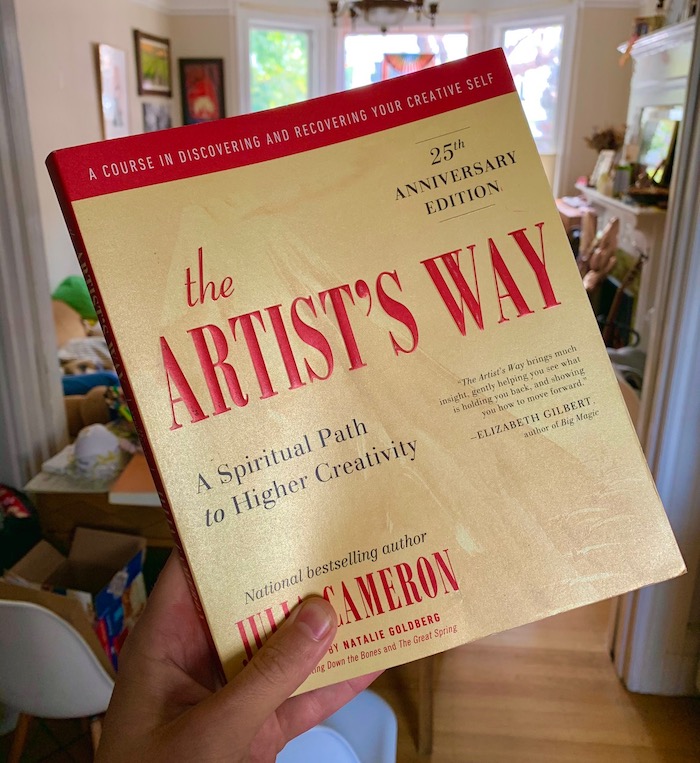My Experience with "The Artist's Way"
Creativity is an innate gift we all possess. And it’s part of our nature to use that creativity. I firmly believe this, and so does The Artist’s Way author, Julia Cameron. Unfortunately, for most of us, it’s stamped out at an early age by education, society, friends, family, and other cultural norms. A lucky few get encouragement at a young age, or have enough creative energy to push through those headwinds, but the rest of us are left thinking we aren’t “creative.” Fortunately, Julia is here to undo that damage.

As one of my quarantine activities I read this book, and boy am I glad I did. And by “read” I mean I surrendered myself to the 12 week program, which is structured as a weekly essay followed by a few exercises. I left it feeling not only more creative, but also more confident in my creativity. It broke down mental blocks I had put up over my whole life. Society telling us why we can’t follow our passions. The voices telling us no. The inner critic that says your work isn’t good enough.
Now I’m less afraid of following my creative urges. Instead of worrying about it being “good” or asking what the “point” of it is, I can jump into it. Feel like writing some short fiction? Go for it. Want to paint a drug-fueled hallucination on your iPad? Sure man. I’ll just do it, even if it has no immediate purpose beyond indulging my inner artist.
To get there, you do two key activities throughout the program: daily morning pages, and weekly artist dates.
The morning pages are a simple, yet surprisingly powerful tool. You write 3 pages of whatever thoughts come to mind. Without stopping. Every morning. By doing so, you empty your head of all the random thoughts you have swirling around. The lingering doubts, the worries, your to-do list, whatever is weighing you down. You’re quieting the voices in your head so that your creative voice can come through loud and clear.
I regularly find myself exploring ideas on the page, like the visual design of an app, or a blog post I’m writing, or a problem I’m wrestling with at work. It helps me develop these ideas, which I then draw on later in the day.
The morning pages also make me feel calmer. Fears, worries, concerns, and anything else bopping around feels more like a passing cloud now. I’m more aware of the transient nature of my thoughts.
While the morning pages gets stuff out of your head, the artists dates gets stuff into your head. They “fill up the creative tank,” as she says. The idea is to indulge whatever creative impulses or curiosities you have by going to museums, buying that book on typography you’ve been eyeing, taking that figure drawing class you’ve always been curious about, and so on. You’re both gathering inspiration and learning to listen to your inner artist’s desires.
While you do those two activities throughout the program, you also do weekly exercises to explore specific aspects of your creativity and what’s holding you back. They include things like blurting all your fears and doubts onto a page, gathering imagery of how you envision your life in the future, writing letters to yourself from age 8 and 80, and more. None of them on their own are profound, but taken together, over 12 weeks, they transform you.
One exercise that did stick with me is affirmations. You write down statements of belief and encouragement (such as “I am a great writer”), then read them after your morning pages. It sounds hokey and woo woo, but actually does help silence your inner critic and build up your confidence.
All of these activities attuned my ear to what my creativity is telling me. I’m more driven by intuition, rather than by what other people expect of me, or society deems “good,” or will impress people. It’s very freeing.
They also got me back to the childlike place of approaching ideas with a sense of play and fun. I can get caught up making something “perfect,” or needing it to serve a purpose like posting on social media to get a million likes (that’s never actually happened before, btw). But now I feel more comfortable just indulging in my creativity without worrying about it being “good” or “shareable” or having any point other than scratching my own creative itch.
Even in my job as the head of a product design team I feel more confident. I more readily pursue the course of action that feels right to me, with less worry about whether it’s objectively “right” or “wrong.”
On that topic, I used to be a lot more concerned whether something was “right” or not (which school stamps into us), rather than accepting that there isn’t one “right” and everyone has their own style. It doesn’t matter if someone else dislikes it, as long as it’s true to me. (I’m still working on internalizing this).
I didn’t feel markedly different or more creative after any particular week or exercise, but when I look back at where I had been I can see there has been a big internal shift. Even now it’s tough to pinpoint and describe, but I know something’s different.
For anyone who’s felt the inner tug to create more (and be honest, that includes you), I couldn’t recommend this book enough. Whatever you’re interested in — painting, writing, strategy, music, law, finance — this book will help you find your inner artist’s voice and live more in tune with your true creative self.
Buy The Artist’s Way on Amazon (affiliate link)